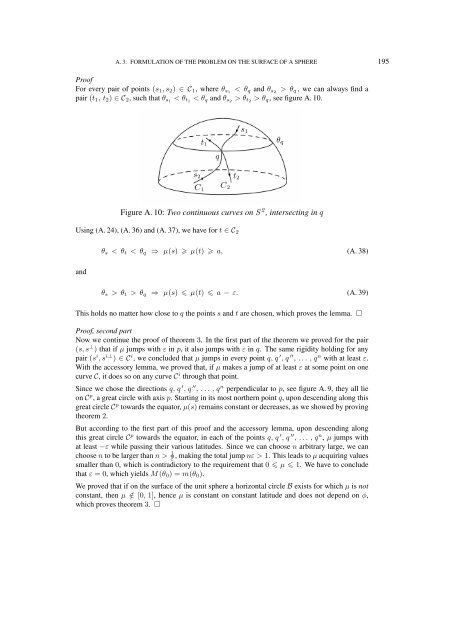FOUNDATIONS OF QUANTUM MECHANICS
FOUNDATIONS OF QUANTUM MECHANICS
FOUNDATIONS OF QUANTUM MECHANICS
Create successful ePaper yourself
Turn your PDF publications into a flip-book with our unique Google optimized e-Paper software.
A. 3. FORMULATION <strong>OF</strong> THE PROBLEM ON THE SURFACE <strong>OF</strong> A SPHERE 195<br />
Proof<br />
For every pair of points (s 1 , s 2 ) ∈ C 1 , where θ s1 < θ q and θ s2 > θ q , we can always find a<br />
pair (t 1 , t 2 ) ∈ C 2 , such that θ s1 < θ t1 < θ q and θ s2 > θ t2 > θ q , see figure A. 10.<br />
s 1<br />
t 1<br />
q<br />
s 2 t 2<br />
C 1<br />
C 2<br />
θ q<br />
Figure A. 10: Two continuous curves on S 2 , intersecting in q<br />
Using (A. 24), (A. 36) and (A. 37), we have for t ∈ C 2<br />
θ s < θ t < θ q ⇒ µ(s) µ(t) a, (A. 38)<br />
and<br />
θ s > θ t > θ q ⇒ µ(s) µ(t) a − ε. (A. 39)<br />
This holds no matter how close to q the points s and t are chosen, which proves the lemma. □<br />
Proof, second part<br />
Now we continue the proof of theorem 3. In the first part of the theorem we proved for the pair<br />
(s, s ⊥ ) that if µ jumps with ε in p, it also jumps with ε in q. The same rigidity holding for any<br />
pair (s i , s i⊥ ) ∈ C i , we concluded that µ jumps in every point q, q ′ , q ′′ , . . . , q n with at least ε.<br />
With the accessory lemma, we proved that, if µ makes a jump of at least ε at some point on one<br />
curve C, it does so on any curve C i through that point.<br />
Since we chose the directions q, q ′ , q ′′ , . . . , q n perpendicular to p, see figure A. 9, they all lie<br />
on C p , a great circle with axis p. Starting in its most northern point q, upon descending along this<br />
great circle C p towards the equator, µ(s) remains constant or decreases, as we showed by proving<br />
theorem 2.<br />
But according to the first part of this proof and the accessory lemma, upon descending along<br />
this great circle C p towards the equator, in each of the points q, q ′ , q ′′ , . . . , q n , µ jumps with<br />
at least −ε while passing their various latitudes. Since we can choose n arbitrary large, we can<br />
choose n to be larger than n > ε 1 , making the total jump nε > 1. This leads to µ acquiring values<br />
smaller than 0, which is contradictory to the requirement that 0 µ 1. We have to conclude<br />
that ε = 0, which yields M (θ 0 ) = m(θ 0 ).<br />
We proved that if on the surface of the unit sphere a horizontal circle B exists for which µ is not<br />
constant, then µ /∈ [0, 1], hence µ is constant on constant latitude and does not depend on ϕ,<br />
which proves theorem 3. □
















